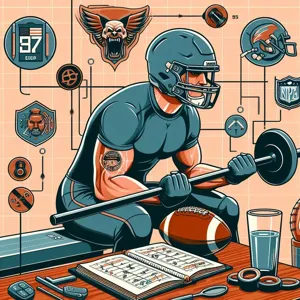Soccer, known as the beautiful game, has a unique ability to unite players of all ages, weaving dreams of glory from the playground to the pitch.
For young aspiring athletes, the journey from kicking a ball in the local park to showcasing their skills on a professional stage can seem daunting. Yet, this transition is not merely a leap; it’s a bridge that, when built with the right guidance, passion, and resources, can unlock incredible opportunities. In this blog post, we will explore the vital connection between youth soccer programs and professional leagues, revealing the steps necessary to nurture talent, instill a love for the game, and foster the next generation of soccer stars. Join us as we delve into the importance of mentorship, community support, and structured pathways that pave the way for young players to turn their playground aspirations into professional achievements. Whether you’re a parent, coach, or player, this guide will illuminate how to effectively bridge the gap and celebrate the journey of soccer from youth fields to professional arenas.
1. Introduction: The Journey from Playground to Pitch

Soccer, known as football in many parts of the world, is more than just a game; it’s a universal language that transcends borders, cultures, and age groups. For many young players, the journey begins on dusty playgrounds or makeshift fields, where they kick around a worn-out ball, dreaming of becoming the next big star. These informal settings, filled with laughter and camaraderie, are where the foundations of passion, teamwork, and skill are laid.
As children revel in the freedom of play, they unknowingly cultivate the attributes that will serve them well on the professional stage: agility, creativity, and resilience. Yet, the transition from these carefree moments to the structured environment of professional soccer can be daunting. It requires more than just raw talent; it demands dedication, discipline, and a strategic approach to skill development.
In this blog post, we will explore the pathways that connect the innocent joy of playground soccer to the high-stakes world of professional leagues. We will examine the crucial stages of development, the role of coaches and mentors, and the importance of fostering a supportive community. By understanding this journey, we can better appreciate the hard work and determination it takes for young athletes to realize their dreams on the pitch. Join us as we bridge the gap between childhood play and the professional arena, highlighting the pivotal moments that shape the future of soccer stars.
2. The Importance of Youth Development in Soccer
Youth development is the cornerstone of a thriving soccer ecosystem, serving as the critical link between grassroots enthusiasm and professional excellence. Investing in youth programs not only shapes the skills of young players but also instills a deep understanding of the game, fostering a generation that is not only talented but also passionate about soccer.
The significance of youth development extends far beyond mere skill acquisition. It encompasses a holistic approach that nurtures physical fitness, teamwork, discipline, and resilience. Young players learn how to navigate the complexities of the game, from mastering technical skills to grasping tactical awareness. This foundation not only prepares them for the rigors of competitive play but also cultivates qualities that benefit them both on and off the field.
Moreover, youth development programs serve as vital community hubs, bringing together families, coaches, and local organizations. These programs create a supportive environment where young athletes can thrive, build lasting friendships, and develop a sense of belonging. Through regular training sessions, matches, and tournaments, players are given the opportunity to showcase their talents, gain valuable experience, and receive mentorship from seasoned coaches who recognize and nurture potential.
As the soccer landscape continues to evolve, the emphasis on youth development becomes increasingly crucial. Professional clubs are now prioritizing youth academies to create pathways for young talent to transition into the professional ranks. By focusing on scouting, training, and mentorship, clubs can identify promising players early on and provide them with the resources necessary to succeed.
Ultimately, the commitment to youth development is an investment in the future of soccer. By bridging the gap between playground games and professional pitches, we ensure that the next generation of players not only possess technical prowess but also embody the values of sportsmanship and dedication that define the beautiful game. As communities rally around these young athletes, the future of soccer shines brighter than ever.
3. Key Skills Developed in Youth Soccer

Youth soccer is not just about learning how to dribble or shoot; it’s a foundational experience that instills a diverse range of skills crucial for both the sport and life beyond the field. As young players lace up their cleats and step onto the grass, they embark on a journey that nurtures their physical, mental, and social development.
**Teamwork and Collaboration:** One of the most significant skills gained from youth soccer is the ability to work as part of a team. Players quickly learn that success is not solely dependent on individual talent but rather on how well they can communicate and collaborate with their teammates. This understanding fosters a sense of camaraderie and teaches them the importance of supporting one another to achieve a common goal.
**Discipline and Commitment:** Regular practices, games, and the need to hone skills instill a sense of discipline in young athletes. They learn to be committed to their training and responsibilities, balancing their soccer obligations with school and other activities. This commitment often translates to other areas of their lives, helping them to become more organized and focused individuals.
**Strategic Thinking:** Soccer is a game of strategy, requiring players to think quickly and make decisions in real-time. Youth players develop critical thinking skills as they learn to read the game’s flow, anticipate opponents’ moves, and figure out the best tactical approaches. This ability to strategize is invaluable, not just on the field but in everyday problem-solving scenarios.
**Resilience and Handling Adversity:** The nature of competitive sports means that young players will face challenges, whether it be losing a match, missing a goal, or dealing with a tough opponent. Through these experiences, they cultivate resilience, learning to bounce back from setbacks and maintain a positive attitude. This capacity to handle adversity is a life skill that will serve them well in various situations beyond soccer.
**Physical Fitness and Health Awareness:** Regular participation in youth soccer promotes physical fitness, teaching children the importance of an active lifestyle. As they engage in practices and games, they develop coordination, agility, and endurance while also gaining an understanding of the significance of nutrition and overall health.
In essence, youth soccer serves as a vital training ground, equipping young players with essential life skills that extend far beyond the pitch. By fostering teamwork, discipline, strategic thinking, resilience, and health awareness, youth soccer lays a strong foundation for future success, both in sports and in life. It’s clear that the lessons learned on the field will resonate long after the final whistle blows.
4. The Role of Coaches in Shaping Young Players
Coaches play a pivotal role in shaping the trajectory of young soccer players, serving as mentors and guides who influence not just their skills on the pitch but also their personal development off it. A good coach recognizes that youth soccer is about more than just winning games; it’s about fostering a love for the sport, instilling discipline, and teaching valuable life lessons.
At the grassroots level, coaches introduce players to the fundamentals of the game, emphasizing the importance of teamwork, communication, and sportsmanship. They create an environment where players can experiment, make mistakes, and learn from them without fear of harsh criticism. This nurturing approach helps build confidence in young athletes, allowing them to express themselves creatively on the field.
As players progress through their formative years, the role of the coach evolves. They become not only instructors of technique and strategy but also key figures in instilling a competitive mindset. Coaches teach young players how to handle pressure, adapt to different game scenarios, and learn from both victories and defeats. They provide constructive feedback that helps players refine their skills and develop resilience—a crucial trait for anyone aspiring to reach the professional level.
Moreover, effective coaches serve as role models, demonstrating the values of hard work, dedication, and respect for others. They foster a sense of community within the team, helping players build lasting friendships and a support system that extends beyond the soccer field. By prioritizing character development alongside athletic training, coaches help young players grow into well-rounded individuals, ready to tackle the challenges of both soccer and life.
In essence, the influence of coaches during these formative years cannot be overstated. Their ability to inspire, teach, and connect with young players creates a strong foundation for future success, bridging the gap between youthful enthusiasm for the game and the rigorous demands of professional soccer. As we continue to explore the journey from playground to pitch, it’s clear that the guidance of skilled coaches is an indispensable part of nurturing the next generation of soccer stars.
5. Understanding the Transition: When to Move from Youth to Professional Levels

Understanding when to transition from youth to professional levels in soccer is a pivotal moment in any aspiring athlete’s journey. This transition is not solely about age or skills; it encompasses a complex interplay of physical, mental, and emotional readiness. As players navigate the youth leagues, they often face the pressure of expectations from coaches, parents, and even themselves. Recognizing the right time to step up can make all the difference in their development.
A crucial factor in determining readiness is the player’s skill set. Assessing technical abilities like ball control, passing accuracy, and tactical awareness can help identify whether an athlete is prepared for the rigors of professional play. Beyond technical skills, physical conditioning is essential. Professional soccer demands peak fitness levels, agility, and endurance that youth players may only begin to develop in their late teens.
Equally important is the mental aspect of the game. Transitioning to a professional environment requires resilience, focus, and the ability to handle the pressures of competition at a higher level. Young players must be prepared for the challenges of training regimes, match day pressures, and even the possibility of setbacks, such as injuries or being benched. A strong support system—coaches, family, and mentors—can significantly influence a player’s confidence and preparedness for this leap.
Furthermore, understanding the timing of opportunities is key. Many players are scouted during tournaments or showcase events, making it essential to perform consistently and stand out. However, it’s also crucial to weigh the potential of jumping into the professional arena against the benefits of continued development in youth programs. Each player’s journey is unique, and taking the time to evaluate personal goals, skills, and the right opportunities will ensure that the transition is not just a step up but a step forward in their soccer career.
Ultimately, the move from youth to professional soccer should be a well-considered decision. While the allure of professional play is strong, ensuring that a player is not only ready but also excited for the challenges ahead is vital for long-term success both on and off the field.
6. Mental Preparation: Building Resilience and Confidence
Mental preparation is a cornerstone of success in soccer, bridging the transition from youth play to the professional pitch. As young athletes move up the ranks, the physical demands of the game often take center stage, but it is the mental aspect that can truly set players apart. Building resilience and confidence is essential for navigating the challenges of competitive soccer.
Resilience is the ability to bounce back from setbacks, whether that means recovering from a tough loss, overcoming injuries, or managing the pressures of high-stakes matches. Young players must learn to view challenges as opportunities for growth rather than insurmountable obstacles. Coaches and mentors play a pivotal role in this process, encouraging a growth mindset and teaching athletes to embrace failure as a necessary step on the road to success. Techniques such as visualization, goal-setting, and positive self-talk can help instill this mental fortitude, allowing players to maintain composure under pressure and adapt when faced with adversity.
Equally important is the development of confidence. A self-assured player is more likely to take risks, showcase their skills, and contribute positively to the team dynamic. Confidence can be nurtured through consistent practice, constructive feedback, and celebrating small victories along the way. Creating a supportive environment, where players feel valued and trusted, fosters this growth. Encouragement from coaches, teammates, and family members can reinforce their belief in their abilities, transforming doubt into determination.
Incorporating mental preparation into training routines is crucial. This can involve mindfulness techniques, such as breathing exercises and meditation, to help players manage anxiety and stay focused during games. Additionally, discussions about mental toughness and the importance of a strong mindset should be woven into the fabric of training sessions.
Ultimately, the journey from playground to pitch is not just about honing technical skills but also about fostering a resilient and confident mentality. By prioritizing mental preparation, young athletes will be better equipped to face the challenges of professional soccer, paving the way for a successful and fulfilling career in the sport they love.
7. The Influence of Grassroots Programs on Professional Opportunities

Grassroots programs serve as the foundational bedrock of youth soccer, nurturing young talent and fostering a love for the game that can lead to professional opportunities. These initiatives, often community-driven and accessible to all, play a vital role in bridging the gap between playground games and professional pitches. They provide not only training and skill development but also instill important life lessons such as teamwork, discipline, and resilience.
At the heart of grassroots programs is the emphasis on inclusivity. They allow children from diverse backgrounds to come together, learn the fundamentals of soccer, and gain exposure to the sport. Coaches, often former players or passionate volunteers, dedicate their time to hone the skills of these budding athletes, creating an environment where potential can flourish. Many professional soccer players cite grassroots programs as the springboard for their careers, recalling how these early experiences shaped their understanding of the game and their personal development.
Moreover, grassroots initiatives often serve as a direct pathway to professional opportunities. Many clubs and organizations scout talent at the local level, frequently holding tournaments and showcases to identify skilled players. These events can be pivotal for young athletes, as they provide a platform to demonstrate their abilities in front of scouts and coaches from higher-level leagues. As a result, many young players make the leap from local fields to professional academies, where they can further refine their skills and pursue a career in soccer.
Additionally, grassroots programs contribute to the overall health of the soccer ecosystem. By fostering a passion for the sport among youth, they help build a larger fan base and increase participation rates. A vibrant youth soccer community not only creates more opportunities for aspiring professionals but also strengthens the sport’s cultural presence in society.
In conclusion, grassroots programs are not just about teaching kids how to kick a ball; they are about shaping the future of soccer. By providing essential training, promoting inclusivity, and offering pathways to professional opportunities, these initiatives play a crucial role in ensuring that the next generation of soccer stars can transition smoothly from the playground to the pitch.
8. Training Regimens: Balancing Fun and Skill Development
When it comes to nurturing young soccer talent, striking the perfect balance between fun and skill development in training regimens is crucial. For budding athletes, the primary goal should always be to foster a love for the game while simultaneously honing their abilities. This dual focus not only keeps players engaged but also lays the groundwork for their future success on the pitch.
Training sessions should be designed to incorporate a variety of fun activities that captivate young players’ imaginations. Think of small-sided games, obstacle courses, and creative drills that mimic real match scenarios. These engaging exercises not only enhance technical skills such as dribbling, passing, and shooting but also encourage teamwork and sportsmanship. For instance, setting up a shooting challenge where players compete against each other can ignite their competitive spirit while improving their accuracy and decision-making under pressure.
However, it’s essential that these sessions are not solely focused on competition. Coaches should emphasize the importance of learning through play, allowing players to experiment with new techniques without the fear of failure. This approach nurtures creativity and a sense of exploration, enabling young athletes to develop their individual styles. Furthermore, integrating feedback and positive reinforcement into training fosters a growth mindset, encouraging players to understand that skill development is an ongoing journey.
As players progress, training regimens can gradually introduce more structured drills that emphasize specific skills and tactical awareness. Incorporating video analysis or team discussions can also help bridge the gap between fun and professional development, allowing youth athletes to grasp the intricacies of the game while enjoying the camaraderie of their teammates.
Ultimately, the goal is to create an environment where young soccer players feel excited to train and grow. By balancing fun with skill development, we can ensure that the next generation of athletes not only enjoys their time on the field but also emerges as well-rounded players ready to take their talents from the playground to the professional pitch.
9. The Impact of Family Support and Community Engagement
In the journey from playground to pitch, the influence of family support and community engagement cannot be overstated. For young aspiring soccer players, the backing of their families often serves as the bedrock of their development, both emotionally and practically. Parents who encourage their children to pursue their passion for soccer not only nurture their talent but also instill a sense of discipline and commitment. From weekend games to early morning practices, the dedication shown by families—whether it’s carpooling teammates, organizing snack rotations, or simply cheering from the sidelines—creates an environment where young athletes can thrive.
Equally important is the role of the community. Local clubs, schools, and recreational leagues foster an inclusive atmosphere where young players can learn the fundamentals of the game while developing important life skills such as teamwork, resilience, and sportsmanship. Community engagement helps create a pipeline that connects youth players to professional opportunities, often through mentorship programs, workshops, and showcases that highlight local talent.
Moreover, supportive communities can rally around their young athletes, providing resources, facilities, and sponsorships that can significantly impact a player’s growth. When families, coaches, and community members work together, they build a nurturing ecosystem that celebrates achievements, encourages participation, and inspires the next generation of soccer stars. The culmination of family support and community involvement not only bridges the gap between youth soccer and the professional pitch but also reinforces the notion that soccer is more than just a game; it’s a powerful vehicle for personal and communal growth.
10. Success Stories: Players Who Made the Transition
Success stories are the heartbeat of soccer, illustrating how dreams can evolve from playground play to professional pitches. These narratives inspire countless young athletes who aspire to turn their passion for the game into a career. Take, for instance, the remarkable journey of Lionel Messi. Discovered at a young age while playing in the streets of Rosario, Argentina, Messi faced numerous challenges, including a growth hormone deficiency that threatened to derail his future. However, with the unwavering support of his family and a pivotal move to Barcelona’s youth academy, La Masia, Messi honed his skills and rose to become one of the greatest players of all time.
Similarly, consider the story of Alex Morgan, who started out playing soccer in her backyard in California. Through hard work and determination, she navigated her way through youth leagues and college soccer, eventually earning a spot on the U.S. Women’s National Team. Morgan’s success is a testament to the importance of perseverance and how early experiences on the field can foster skills that lead to national recognition and international stardom.
Then there’s Raheem Sterling, who grew up in a challenging environment in Jamaica before moving to London. His journey through the youth ranks of Queens Park Rangers showcased his talent and dedication, ultimately leading him to a successful career with Manchester City and the England national team. These stories highlight that while talent is crucial, the path to professional soccer is often paved with resilience, sacrifice, and the ability to seize opportunities.
These players not only serve as role models but also underscore the importance of grassroots programs and community support in nurturing young talent. Their transitions from local fields to global stadiums remind aspiring athletes that, with the right guidance and unwavering passion, the leap from youth soccer to the professional arena is indeed possible. Through their experiences, young players are encouraged to dream big, knowing that with dedication and perseverance, they too can write their own success stories on the pitch.
11. Overcoming Common Challenges in the Transition Process
Transitioning from youth soccer to the professional pitch is an exhilarating journey, yet it is not without its challenges. Young athletes often face a myriad of hurdles that can hinder their progression, both physically and mentally. Understanding these common obstacles is crucial for players, coaches, and parents alike, as it allows for proactive strategies to be implemented.
One of the primary challenges is the abrupt shift in competitive intensity. Youth soccer is often characterized by a more nurturing environment, where players are encouraged to explore, learn, and grow without the pressure of high stakes. In contrast, professional settings demand higher levels of performance, commitment, and resilience. This transition can be overwhelming, leading to anxiety and self-doubt among young players. To combat this, it’s essential to cultivate a mindset that embraces challenges as opportunities for growth. Regular mental conditioning sessions, guided by sports psychologists, can equip players with the tools needed to manage stress and maintain focus.
Another significant hurdle is the physical demands of professional soccer. The pace of the game increases dramatically, requiring players to enhance their speed, agility, and endurance. Young athletes often find themselves struggling to keep up with older, more experienced competitors. Implementing tailored strength and conditioning programs during the transitional phase can help bridge this gap, ensuring that players are physically prepared to meet the demands of the professional game.
Additionally, navigating the complexities of professional contracts, sponsorships, and media attention can be daunting for young athletes. Many may feel unprepared to handle the business side of sports, which can detract from their focus on the game. Education on these topics—ranging from financial literacy to media training—can empower players to take control of their careers, allowing them to focus on honing their skills on the field.
Lastly, the emotional toll of leaving behind friends and familiar environments in youth soccer can lead to feelings of isolation. Building a supportive community that fosters connections among young players transitioning to the professional level is vital. Mentorship programs, where experienced players guide newcomers, can provide invaluable support, helping them navigate not only the game but also the emotional landscape of their new journey.
By acknowledging and addressing these challenges, we can create a supportive framework that not only eases the transition for young soccer players but also sets them up for long-term success in their professional careers.
12. The Role of Scouting and Talent Identification
Scouting and talent identification serve as the critical bridge connecting youthful exuberance on the playground to the polished performance expected on the professional pitch. In the vibrant world of soccer, where raw talent and potential often emerge in the most unexpected places, the scouting process becomes an art and a science—a meticulous quest for diamonds in the rough.
Scouts play a pivotal role in this journey, equipped with an eye for talent that transcends mere statistics. They traverse local fields, community leagues, and youth tournaments, seeking out young players who not only possess technical skills but also exhibit an innate understanding of the game. A player’s attitude, work ethic, and ability to perform under pressure are just as important as their footwork and agility. It’s in these informal settings that the essence of a player’s character and potential can truly shine.
Moreover, the digital age has transformed scouting into a more inclusive and expansive endeavor. Video analysis and online platforms have enabled scouts to connect with potential talents across regions and even continents. By utilizing social media and video-sharing sites, young players can showcase their skills to a global audience, breaking down geographic barriers that once limited exposure.
Talent identification doesn’t just stop at the initial discovery. It involves comprehensive assessments that take into account a player’s development over time. Clubs often implement structured training programs and mentorship initiatives, ensuring that young athletes have access to the right resources and guidance. This holistic approach helps nurture their skills while fostering a love for the game, ultimately preparing them for the rigors of professional soccer.
In bridging the gap between playgrounds and pitches, effective scouting and talent identification create pathways for youth to realize their dreams. By recognizing and cultivating potential at an early age, the soccer community not only champions the next generation of players but also enriches the sport itself, ensuring its vibrancy and competitiveness for years to come.
13. Creating Pathways: The Importance of Soccer Academies
Creating pathways for young talent is essential in bridging the gap between youth and professional soccer, and soccer academies play a pivotal role in this process. These academies serve as the nurturing grounds where budding athletes can refine their skills, develop discipline, and gain invaluable experience in a structured environment. Unlike traditional youth teams, which often focus solely on game results, soccer academies emphasize holistic development, encompassing technical, tactical, physical, and psychological aspects of the sport.
At a well-run academy, young players are exposed to high-quality coaching, often by former professional players or certified trainers who understand the nuances of the game. This insight is crucial, as it provides aspiring soccer stars with the tools they need to excel at higher levels. Training sessions are designed to mimic the intensity and demands of professional play, giving players a taste of what it takes to compete at the top.
Moreover, soccer academies often have established partnerships with local clubs and professional teams, creating a direct pathway for players to advance their careers. This collaboration is beneficial not only for the players but also for the clubs, as they gain access to a steady stream of skilled talent eager to make their mark on the game. Opportunities for scouts to observe these young athletes are abundant during academy tournaments and showcases, increasing the chances of players being noticed and signed.
Importantly, soccer academies also focus on character building, teamwork, and leadership skills, preparing players not just for the field, but for life beyond soccer. They instill a strong work ethic, resilience, and the ability to handle pressure—qualities that are essential for success in any profession.
In essence, by investing in soccer academies, we are creating structured pathways that lead from playgrounds to professional pitches, ensuring that the next generation of soccer stars has the support, resources, and opportunities needed to realize their dreams. This commitment to youth development not only enhances the quality of the sport but also fosters a culture of passion and dedication that will resonate for years to come.
14. Conclusion: Fostering a Seamless Transition for Future Generations
As we draw this exploration of bridging the gap between youth and professional soccer to a close, it’s evident that fostering a seamless transition for future generations requires a multifaceted approach. The journey from the playground to the pitch is not just about honing technical skills; it’s about nurturing a holistic environment where young players can thrive both on and off the field.
Coaches, parents, and clubs must collaborate to create pathways that support not only athletic development but also personal growth. This includes implementing mentorship programs that connect aspiring players with seasoned professionals, offering workshops that emphasize the importance of mental resilience, and promoting a culture that values teamwork, discipline, and sportsmanship.
Additionally, investment in grassroots initiatives is crucial. By providing access to quality training facilities, competitive leagues, and educational resources, we can ensure that talented youth are not left behind but instead cultivated into the stars of tomorrow. The implementation of scholarship programs can also broaden access, allowing players from diverse backgrounds to pursue their soccer dreams without financial barriers.
Ultimately, the goal is to inspire and empower the next generation, instilling in them a passion for the game and the belief that they can succeed at any level. With collective effort and a commitment to fostering a supportive environment, we can create a seamless transition from playground to pitch, ensuring that future generations experience the joy and fulfillment that soccer can offer. As we look ahead, let us champion a culture that celebrates every player’s journey, recognizing that each step taken in youth soccer is a vital part of a much larger narrative.
15. Call to Action: Supporting Youth Soccer Initiatives in Your Community
As we reflect on the journey from the playground to the professional pitch, it becomes evident that nurturing young talent requires more than just passion; it demands active community involvement. This is where you come in. Supporting youth soccer initiatives in your community is essential for cultivating the next generation of players and fostering a love for the game.
Consider volunteering your time at local soccer clinics or coaching youth teams. Your experience and enthusiasm can inspire young players, helping them develop not only their skills but also their confidence and teamwork. If coaching isn’t your forte, there are myriad ways to contribute. Whether it’s organizing fundraising events, donating equipment, or simply spreading the word about local programs, every effort counts.
Moreover, you can advocate for increased access to soccer facilities and resources within your community. Collaborating with schools, local businesses, and soccer associations can lead to the establishment of scholarships, training camps, and tournaments that provide invaluable opportunities for young athletes.
Additionally, consider becoming a mentor to aspiring players. Sharing your knowledge about the sport, career pathways, and the importance of education can significantly impact their lives. It’s not just about soccer; it’s about shaping well-rounded individuals who can thrive both on and off the field.
By engaging in these initiatives, you are not only helping to bridge the gap between youth and professional soccer but also investing in the future of the sport. Your support can transform dreams into reality, ensuring that every child has the opportunity to lace up their cleats and chase their passion. So, take action today—join the movement to uplift youth soccer in your community and watch as the next generation of stars takes flight.
In conclusion, the journey from playground to pitch is not just a transition; it’s a transformative process that shapes the future of soccer at every level. By fostering a strong connection between youth players and professional clubs, we can cultivate talent, instill a love for the game, and empower the next generation of athletes to reach their full potential. As coaches, parents, and players, let us work together to bridge this gap, ensuring that the dreams nurtured on local playgrounds can flourish into professional aspirations. With the right support and resources, we can create a thriving soccer community that celebrates passion, skill, and dedication—where every child has the opportunity to experience the beautiful game in its highest form. Thank you for joining us on this exploration, and let’s continue to champion the journey from youth to professional soccer!
































